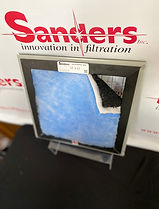RECOGNIZING THE PROBLEM
Although it is not traditionally thought about, the air is the largest surface in any building and must be cleaned, like any other surface in the building. Our Sanders Solution finally allows for a method to efficiently, quickly, & cost effectively address this issue.
To hear founder Scott Sanders explain airborne particles and the capturing process watch this short video presentation.

Airborne contamination is a complex mode of transmission where many of the remaining communicable diseases are able to enter our body and cause harm. Airborne Transmission has the highest rate of transmission possible, indirect, person-to-person. This process is explained in the ASHRAE Position Paper, “Airborne Infectious Disease,” 2009.
This document stipulates that Measles, Mumps, Influenza, and TB are all spread as Airborne Droplet Nuclei, submicron particles. Additionally, ASHRAE provided a statement on airborne transmission of SARS-CoV-2:
“Transmission of SARS-CoV- 2 through the air is sufficiently likely that airborne exposure to the virus should be controlled. Changes to building operations, including the operation of heating, ventilating, and air-conditioning systems, can reduce airborne exposures.”
However, the current filters that are used in almost all residential and light commercial systems are exclusively used to protect the coil of the HVAC system, providing purely a mechanical function. These filters do little to nothing to protect from the sub-micron pathogens that can travel through the HVAC system, possibly infecting people who would never come into contact.
What pathogens are in the air?
COVID-19 has made us all aware of how important what we breathe in. Imagine if you could provide the equivalent of an N95 mask to your entire building - Now you can.

COVID-19 is not the only airborne pathogen to be concerned about

You have the ability to remove 96-99% of the particles the size of known pathogens in the air - with each air change.
What is an air change?
Your running HVAC system cycles the air in your system, on average, 6-10 times per hour. With each one of those cycles, our filters are providing 96-99% reduction in the particles the size of know pathogens.


Why Do I need Such High Filtration?
